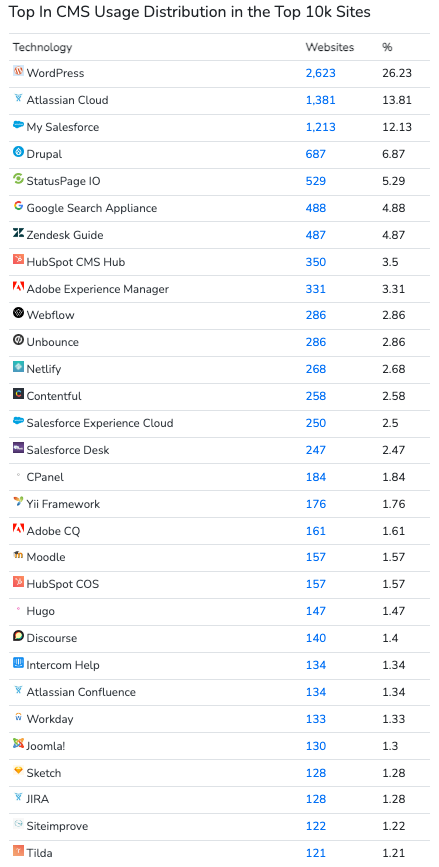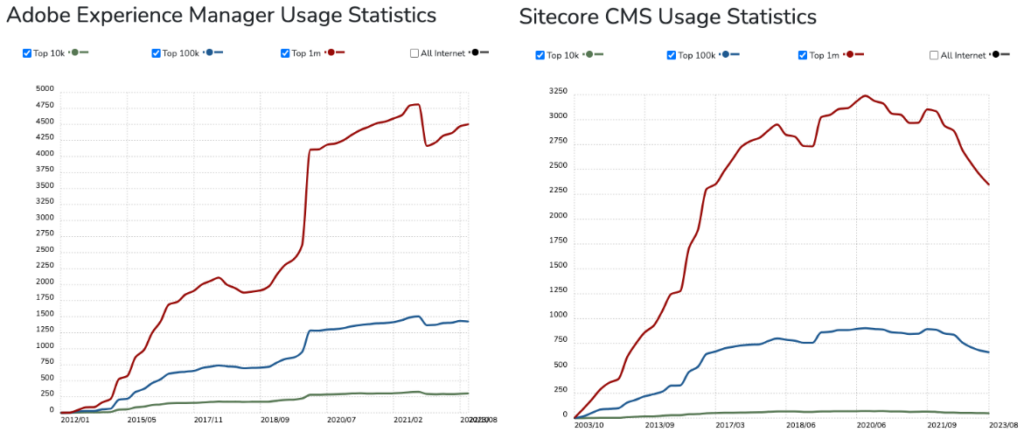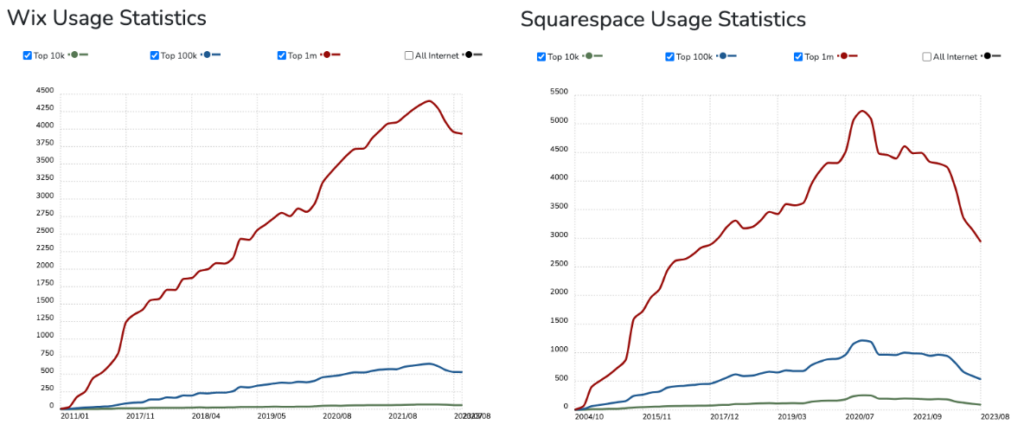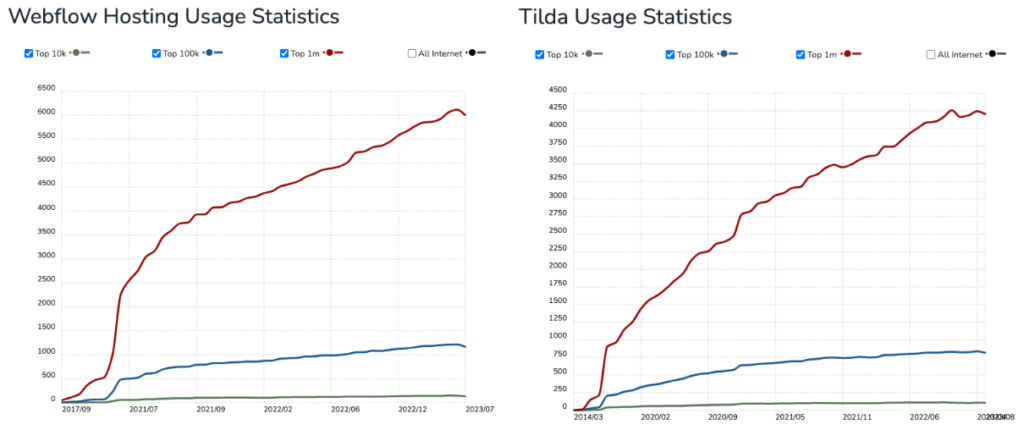In Part 1 of this article, we looked at potential indicators that open source content management systems, which have dominated and defined the past two decades, have peaked and are on the decline. If we imagine a near future where open source may not be in the RFP for your next website, what other technologies are thriving in the market today that could determine your next CMS choice? Here in Part 2 we’ll explore the different models and what attributes are driving adoption.
In Part 1, we discussed WordPress, Drupal and Joomla from the open source camp and the challenges those frameworks now face after a long period of market leadership. To think about what might be coming next, we’ll now dig into trends for competing CMS models with strong market adoption.
Below is a snapshot of the top 30 platforms serving pages for the 10k highest traffic websites worldwide. With the caveat that traffic skews towards publishing use cases, this metric is useful to gauge which products are “enterprise grade” and up to the task to do heavy lifting for sites that serve mass audiences, support large publishing teams, house thousands of pages, or all of the above. While many of these systems are not content management systems in the narrowest definition of the software category, the list provides a picture of the mosaic of systems that comprise websites at the enterprise level (a single website may use more than one of these platforms).

Unsurprisingly, WordPress tops the list, powering 26.2% of the highest traffic sites in the world. WordPress is not just the global leader because of its popularity among small and midmarket users, it has captured pole position in the enterprise tier as well.
But what to make of the diverse mix of brands that make up the rest of this list? I personally was surprised to see some of these logos (hello Atlassian!). To start to make some sense of this, I’ve roughly bucketed this list by category (numbers indicate position on the list).
“Primary” content management systems that serve pages for marketing and engagement
Open source PHP platforms (36.2%)
- 1. WordPress
- 4. Drupal
- 17. Yii Framework*
- 26. Joomla
CRM platforms (19.7%)
- 8. Hubspot CMS Hub
- 14. Salesforce Experience Cloud
- 20. Hubspot COS
DXP platforms (4.9%)
- 9. Adobe Experience Manager
- 18. Adobe CQ
Landing page platforms (2.9%)
- 11. Unbounce
Decoupled platforms (front- or back-end) (6.9%)
- 12. Netlify
- 13. Contentful
- 21. Hugo
No/low code platforms (4.1%)
- 10. Webflow
- 30. Tilda
*Yii is a PHP framework for developing web apps, not a full fledged CMS
Secondary systems that perform specialized non-marketing functions
Helpdesk, customer support + ticketing platforms
- 2. Atlassian Cloud
- 5. StatusPage IO
- 7. Zendesk Guide
- 15. Salesforce Desk
- 28. JIRA
Website admin utilities
- 6. Google Search Appliance
- 16. CPanel
- 29. Siteimprove
Course management platforms
- 19. Moodle
Discussion forum platforms
- 22. Discourse
Wiki + knowledge base platforms
- 23. Intercom Help
- 24. Atlassian Confluence
Business ops platforms (finance, HR, planning, etc.)
- 25. Workday
Design Tools
- 27. Sketch
Focusing on the “primary” content management platforms listed on the left, what does this data imply about the direction of the CMS market? Below, I’ve collected my impressions for the five categories following the open source platforms.
CRMs are eating the internet
Blue State recently received an RFP from a global nonprofit to migrate their suite of websites to a new CMS. The RFP included a diagram mapping the complete user experience of the new platform, including logged in and transactional areas. Three quarters of the diagram would be served by various Salesforce systems, and one quarter would be pages served from the new CMS.
We see this as a good illustration of the journey of many of our enterprise clients over the past 5-6 years. More and more functions are being taken over by Salesforce (or, in a few cases, Hubspot), and consequently more of the annual budget is going to the CRM providers, often at the expense of investments in aspects of the website served from the CMS.
So it is not surprising that of the top 20 platforms serving the highest trafficked sites worldwide, one out of five include Salesforce and Hubspot products. By volume, CRMs are nipping at the heels of the PHP content management systems – WordPress, Drupal and Joomla collectively are in the stack for 36.2% of the highest traffic sites, while 19.7% include Salesforce and Hubspot.
The appeal to serve certain web experiences from the CRM platform directly is understandable as the platform handles authentication and all of the associated security and privacy concerns, the pages are highly personalized, and data is captured directly in the marketing database to power analytics and automation. Hubspot has gone the extra step to offer a full-fledged CMS tuned for B2B marketing. There is an agency in our network who specialize in developing open source websites, but use Hubspot CMS for their own site. Why? Because it is far less effort to use Hubspot’s built-for-purpose solution than to develop similar functionality in an open source CMS.
Might Salesforce also take this step and launch a CMS? If they did, how many of their current customers – including many nonprofits – would ditch their current CMS to come on board? This question keeps us up at night.
Adobe is keeping the DXP flame alive
In the mid-2010s, Adobe bullied into the enterprise website market, selling the vision of a monolithic digital experience platform (DXP) that would allow marketers to automate customer/constituent journeys across every digital marketing touchpoint, gathering intelligence at each step and guiding users to desired actions. Better yet, the tools would put control in the hands of marketers, reducing reliance on technical administrators and developers. Although customers have described experiences often falling short of this lofty goal, the success of Adobe’s sales program shaped expectations in the market for the level of integration across the marketing stack and ushered a shift in gravity for decision making for enterprise martech roadmaps from the CTO to the CMO.
Competitors at the time – particularly Sitecore and Acquia – rushed to build similar offerings, also stitching together acquisitions to bridge the website CMS with media, social and email marketing. At the time, Blue State saw a few of our larger clients sign on to one of the DXP platforms, but today we do not see RFPs from nonprofits looking to move in this direction. The market has cooled on the idea that a single provider is going to provide best in class capabilities in each channel, and the buzz today is around “composable” stacks of best in breed tools that prioritize data integration and interoperability.
So it is interesting to see that Adobe still holds a 4.9% share of the highest traffic websites. It is a testament to the effectiveness of their marketing from 2015 to 2019, but since the start of the pandemic growth has flattened.

Adobe remains dominant in a model now out of vogue. Sitecore, once its leading rival, is rapidly sinking. Where will Adobe go from here as the market looks to the CRM, rather than the DXP, as the control center of digital marketing?
Using a separate CMS for landing pages is… ok?
It is interesting to see Unbounce at #11 on this list, included in 3.3% of the top 10k sites. This landing page management platform – a leader among several competitors – is specialized for B2B and B2C marketing, allowing non-technical marketers to build and optimize landing pages without developer support.
It is also quite common for nonprofits to use a specialized platform – Luminate, Neon, Engaging Networks, EveryAction, Classy, etc. – to manage the landing pages which contain their fundraising and engagement forms that are separate from the CMS used for the main website. In fact, in our experience, it is far less common to integrate transactional functionality into WordPress or Drupal directly. In part this is to minimize security and PII risks, but it is also simply far less admin effort to use these built-for-purpose tools, even if it requires managing content and experience design in two systems. The volume of pages served from Unbounce suggests the commercial world shares the same view.
We often see a divergence in the organizations we work with where separate teams own the main website (and its communication functions) and the donation landing pages, and these teams have their own agency partners for strategy, creative, optimization and technical support. We recognize that in most cases the tool for all things website and the tool for all things donations cannot be one and the same. But hardening organizational divisions around the division in tools is often an unfortunate extension or consequence of the technology divergence. We have seen situations where agencies working for different divisions have set up competing personalization or A/B testing that only comes to light during crucial campaigns. This often leads to fragmentation of user experience and data, worsening organizational silos and making it difficult to implement a cohesive user journey.
So, using different tools built-for-purpose for different functions may often be necessary, or even sometimes a best practice, but efficiency and success working in this model requires organizations to resist siloing and take steps to become more integrated and collaborative between communications and fundraising teams.
Decoupled frameworks have a seat at the table
Decoupled – also called “headless,” “jamstack” and “edge” – architectures have also transformed areas of the website market since the mid 2010s. These development models separate the content management system (where editors manage content and editorial workflows) from the application that serves the user-facing portion of the website, for benefits described below.
Back in the 2000s, WordPress and Drupal flourished precisely because the CMS combined content administration with front-end theming, providing non-technical editors more agency to build and edit the content and design of website pages. It was also straightforward for a small developer team, or even a single developer, to install and set up and keep running. Combined, these innovations led to the dominance of WordPress we see today. However, the integration of the code that renders the front end with the code communicating with the database on the back end creates a ceiling on performance. The shift to mobile browsing over the past decade has highlighted the limitations of integrated WordPress and Drupal websites, where optimization efforts often struggle to deliver page loads under 2 seconds, a critical threshold for bounce rates, particularly for ecommerce sites.
Decoupled architectures can serve pages faster and are more secure because the application and database are not integrated with the front end. Collectively, Netlify, Contenful and Hugo – all built to serve the decoupled development model – are involved in 6.9% of the highest traffic websites, higher than the market share of Adobe and even with Drupal.
The WordPress ecosystem has very much taken note of this trend. WordPress can be employed as the CMS in a decoupled architecture, and WP-Engine has invested heavily in servicing this model as a primary focus of their platform. Of particular note, in 2022, WP Engine acquired the ubiquitous Advanced Custom Fields plugin to better support component page building in decoupled sites. In 2023, Pantheon also launched their own offering for decoupled architectures. Again, ecommerce is the primary use case targeted by these providers.
Because decoupled websites require ongoing developer support to innovate and evolve, we have seen limited adoption of this framework in the nonprofit space, where teams are small and more focused on editorial and marketing roles. But it is notable that as a fairly recent entrant in the field, the decoupled bloc now has a firm foothold among the frameworks in the top tier of highest traffic sites.
No/low code is (finally) ready for its close-up
Facebook’s public launch of the React Javascript Framework in 2013 marked a paradigm shift in how websites are built. React is an open-source front-end JavaScript library for building user interfaces based on components, which modern content management systems have subsequently adopted to make page building more visually intuitive for non-technical editors.
This shift sparked the rise of decoupled development frameworks, but also commercial platforms like Wix and Squarespace that use drag-and-drop interfaces and prebuilt templates to allow non-developers to build entire websites. This development approach is known as “no code” (or “low code” if there are spots that require small bits of coding). No code platforms have proved massively successful – today Wix and Squarespace account for 15% of all websites on the internet. Notably, however, neither ranks highly on the list of platforms for the 10k highest traffic sites.
Despite their meteoric adoption by individuals and small business users since 2011, Wix and Squarespace are too templated and too restrictive for enterprise users. Even in the small and mid-market tiers, both platforms appear to have hit their ceiling and market share has started to decline.

There is, however, a no/low code platform sitting at #10 for the highest traffic sites: Webflow. Webflow was founded in 2013, but has seen rapid growth in the past three years. At #30 on the list, we also see Tilda, another website builder aimed at non-technical users, which is on a similar rising trajectory.

Webflow’s spin on the no/low code model provides a framework that is flexible enough to create the highly customized designs desired by enterprise brands, paired with a baseline set of APIs and pre-built integrations to meet many enterprise business requirements. It’s more complex than Wix and Squarespace, but simpler to deploy and maintain than WordPress, striking a balance that is driving adoption at the enterprise level.
But in conversations with web agency peers, I see something else at work in the recent surge of interest in Webflow: simple loss of enthusiasm and patience with WordPress and Drupal. Some developers are finding that for marketing websites with straightforward features like lead generation forms, if they can get 90-95% of the desired experience building in Webflow, building in WordPress or Drupal feels like a tedious chore in comparison. They just don’t want to do the work if they could be developing something else that is more interesting. Webflow allows them to significantly cut down the time to launch marketing sites and avoid the ongoing hassle of maintaining software updates and security patches.
There is a trade-off to assess for the overall cost of ownership. Webflow’s pricing model is a complex menu of subscription fees based on the website size (including number of pages, assets, web traffic, etc.), the number of designer and editor seats, à la carte features, and hosting SLA level. The total price tag needs to be weighed against the ongoing hosting and maintenance costs of a comparable WordPress and Drupal site. Webflow’s solid – and rising – market share in the enterprise tier suggests that many organizations find the cost calculations to be favorable.
Webflow held its annual conference in October, and attending the event in New York, I was struck by how a majority of the speakers, either from agencies or brands, stressed how excited they were to have moved to Webflow from WordPress. The Webflow community explicitly identifies as post-WordPress, and may be honing a narrative that will resonate if WordPress is perceived to have hit its ceiling.
Going into 2024, we’ll be looking closely at whether the nonprofit field will also begin to adopt no/low code platforms like Webflow and Tilda.